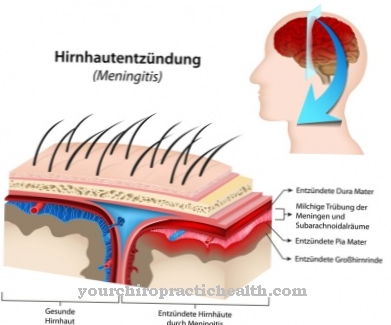Cluster headache is characterized by periodically occurring unilateral pain attacks of the greatest intensity in the area of the temples and eyes, which primarily affect young men. Due to the unexplained etiology of cluster headache, there are no causal therapies (therapy aimed at the causes). However, if therapy is started early, cluster headaches can be treated well with medication.
What is cluster headache?

A cluster headache is an area-dependent pain condition associated with the most severe unilateral pain attacks in the temples and eyes. The pain attacks occur in bundles (in clusters) up to eight times a day and can last 15 to 180 minutes if left untreated.
In 80 percent of the cases, the periodically occurring pain attacks (sometimes over weeks to months) alternate with symptom-free intervals lasting months or years (episodic cluster headache). In 20 percent of the cases, however, there is a chronic cluster headache, which is characterized by pain attacks lasting over a year without remission phases (symptom-free phases of at least four weeks).
causes
The causes of cluster headache are not exactly understood. Since the attacks occur more frequently in spring and autumn (meteorological transition phases), disturbances of the biorhythm are suspected as possible causes.
In addition, since the attacks in cluster headache occur more often at the same time of day, dysregulations are suspected in those areas of the brain that, among other things, regulate the sleep-wake rhythm (hypothalamus).
In addition, genetic causes for cluster headache are assumed, although no single gene responsible for the disease has yet been identified. However, the likelihood of cluster headache is greatly increased (18 times) if a first-degree relative has the condition.
Furthermore, specific trigger factors such as alcohol and nicotine consumption, bright or flickering light, mountain air, physical exertion and certain vasodilating agents (histamine, nitrates) can trigger attacks of cluster headache.
Symptoms, ailments & signs
Cluster headache is characterized by sudden, violent boring or cutting headache. The patients feel stabbing pain behind the eye, which feels like a red-hot knife in the eye. A headache attack only affects one side of the head. Simultaneous headaches on both sides never occur.
In rare cases, however, the headache can change the side of the head during an attack. In addition to the severe headache, there are also watery eyes, conjunctivitis, eyelid swelling, runny nose, profuse sweating in the face and forehead, and Horner's syndrome on the affected half of the face. Horner's syndrome is characterized by a drooping upper eyelid, a narrowed pupil and an eyeball that has sunk into the eye socket.
Extreme restlessness during a cluster headache attack is also typical. This applies to over 90 percent of those affected. This restlessness manifests itself in the constant running back and forth as well as in apathetic bobbing with the upper body. The seizures occur especially in spring or autumn. Furthermore, the headaches often start at the same time in the early morning or two hours after falling asleep.
However, the intervals between individual headache attacks are often of different lengths. In between there are sometimes weeks or months of symptom-free times. A single seizure can last anywhere from 15 to 180 minutes. Many patients also suffer from depression because of the violent attacks.
Diagnosis & course
Cluster headache is diagnosed based on typical symptoms. In addition to the characteristic pain attacks, reddening of the eyes and face, hyperhidrosis (excessive sweating), rhinorrhea (nasal secretion), lacrimation (lacrimation), miosis (constriction of the pupil), ptosis (drooping upper eyelid), eyelid edema (eyelid swelling) or agitation during the attacks found, cluster headache can be assumed.
A nitroglycerin test (differentiation from migraines or trigeminal neuralgia) as well as neurological and imaging methods (exclusion of tumors as the cause of the complaint) serve as confirmation and differential diagnosis. In addition, an eye examination should be carried out to rule out an attack of glaucoma (glaucoma) that resembles a cluster headache.
Cluster headache usually has a chronic, recurrent course, in which symptom-free intervals alternate with phases that are dominated by pain attacks even after years. However, cluster headache subsides with age in terms of the intensity and frequency of attacks.
Complications
With a cluster headache, the patient experiences a very uncomfortable headache. As a rule, with cluster headaches, the person affected can no longer concentrate and think clearly. The pain can also spread to the teeth, ears and neck and lead to severe pain in these areas as well.
Normal work is no longer possible due to the cluster headache, so that the patient's everyday life is severely restricted by these attacks. This can also have a negative effect on social contacts if the patient withdraws or the cluster headache creates a slightly aggressive mood in the person concerned.
Often times these headaches result in sweating, nausea, and vomiting. Due to the severe pain, there is also a physical restlessness that can even trigger panic attacks. The eyes become red and irritated. In most cases, the cluster headaches will go away on their own within a few minutes.
During this time, however, the patient cannot work or perform any vigorous physical activity. The treatment itself is usually done with painkillers or through the targeted addition of oxygen. If the pain is temporary, there are no further complications. As a rule, however, there is another cause for the cluster headache, so that it can lead to unpredictable complications and other complaints.
When should you go to the doctor?
Headaches that persist for several days or are very severe should always be examined by a doctor. A visit to the doctor is also recommended if the pain spreads or other symptoms arise. Cluster headaches can impair other sensory modalities. Seeing or hearing is often restricted.
Consult a doctor to determine the exact cause. If the one-sided pain leads to reduced performance or a limitation in coping with everyday tasks, a doctor should be consulted. Before taking pain medication, you should always consult a doctor. If you have repeated sleep disorders, if you have a fever or if you have problems paying attention, you should see a doctor. If the headache triggers a bad posture of the head, muscle tension or hardening of the muscles in the neck, shoulder and back area can be triggered.
So that the skeletal and muscular system does not become ill, the complaints should be clarified and treated by a doctor. If the headache leads to decreased food intake, a doctor should be consulted if unwanted weight loss occurs or a feeling of internal dryness occurs. A visit to the doctor is also necessary if psychological or emotional problems arise and the person concerned perceives the stress as very disturbing and impairing.
Doctors & therapists in your area
Treatment & Therapy
The therapy of cluster headache aims on the one hand to relieve pain during the attacks (acute therapy) and on the other hand to avoid further attacks (prophylactic therapy or interval therapy). While conventional pain medication does not help or does not help in an acute cluster headache, inhalation of 100 percent oxygen usually provides pain relief after a few minutes.
In some cases, sumatriptan (subcutaneous self-injection) or zolmitriptan (nasal spray) are used to treat acute cluster headache attacks. These two active ingredients belonging to the group of triptans suppress, among other things, the pain perception and block the release of the pain mediating neuropeptides. In addition to verapamil, lithium, glucocorticoids or methysergide are used prophylactically in the painless interval for episodic cluster headache (interval therapy).
For chronic cluster headache, verapamil or lithium is used as part of long-term therapy. A newer method is the so-called deep brain stimulation by a brain pacemaker. In this process, known as neuromodulation, electrodes are surgically inserted into the hypothalamus, which modify the nerve signals in this brain area by means of appropriate electrical stimuli.
However, this promising procedure, for which no long-term results are available so far, is only used if a drug therapy has remained ineffective or in the case of chronic cluster headache with a very severe course.
Outlook & forecast
The course of the disease cluster headache is chronic and recurrent and a distinction is made between chronic and episodic courses. There is complete freedom from symptoms between the phases of the pain attacks. About 80% of patients have an episodic course. In some cases there is a transition from episodic to sporadic.
In the spring and autumn seasons, the number of affected patients increases significantly. Those affected always report the same times of day when they suffer from severe pain. They usually appear in the morning or immediately after falling asleep.
In addition to the named recurring properties of cluster headache, there may be long pauses between the pain attacks in an episodic course. Patients are often symptom-free for years until a new phase with cluster headaches occurs. The episodic cluster headache lasts for a few weeks or months before disappearing completely.
In the case of a chronic course of the disease, the pain attacks last for over a year until a period of symptom relief comes. Here the intervals until the next occurrence are limited to a few weeks. Permanent spontaneous healing of the cluster headache is possible with both courses at any time. In the phases of pain, the symptoms are reduced by medication. With knowledge of the individual trigger, this can be avoided yourself.
prevention
Since the causes of cluster pain have not been clarified, there are no preventive measures. However, trigger factors such as substances containing histamine and tyramine (contained in alcohol, nuts, cheese, chocolate, tomatoes, citrus fruits, among others) as well as bright or flickering light, mountain air and nicotine consumption should be avoided to prevent cluster headache attacks.
Aftercare
During and after the medically supervised therapy, measures should be taken at home to minimize the symptoms of cluster headaches. It is recommended to take specific dietary supplements:
Affected people often show a lack of magnesium. Taking magnesium supplements can minimize the frequency of cluster headaches. Vitamin B2 can reduce the severity and frequency of attacks. Incomplete relief from conventional treatments may be improved by taking melatonin.
The lifestyle should be adjusted according to the disease. Appropriate physical activity is recommended. Regular exercise stimulates the blood circulation and reduces stress. Yoga classes and meditation can also contribute to alleviation.
Breathing exercises that ensure adequate uptake of oxygen can ease the severity of an attack and reduce its duration. Those affected should also ensure that the sleep rhythm is adhered to and that they go to bed at constant times.
Ginger tea works on the vanilloid receptors and reduces vomiting. It helps alleviate the attacks. It is recommended to drink one to two cups a day. It is also advisable to avoid addictive substances such as alcohol, tobacco or narcotics of any kind. This is especially true during an attack. These substances make the cluster headache symptoms worse.
You can do that yourself
Cluster headaches can only be completely cured in a few cases. However, there are a number of strategies that can help you manage the disease. Since headache attacks are often triggered by so-called triggers, it is primarily advisable to deal with the symptoms carefully.
Do you get a headache after consuming alcohol? Or do the symptoms occur after taking medication, dietary supplements or certain foods? Those affected should answer these questions with the help of a medical diary. Appropriate precautions can then be taken to prevent further attacks or at least relieve symptoms. Typical trigger factors are also noise, flickering light, extreme heat or changes in altitude - these should be avoided at all costs.
If the cluster headache does not decrease despite all measures, therapeutic advice is required. Accompanying this, acute attacks can be alleviated through sport, meditation or autogenic training. Constant observation of the triggers and effective countermeasures can at least reduce the symptoms in the long term. Sometimes, however, cluster headaches can also be relieved by simple medication, which is why those affected should always consult a doctor.



.jpg)























